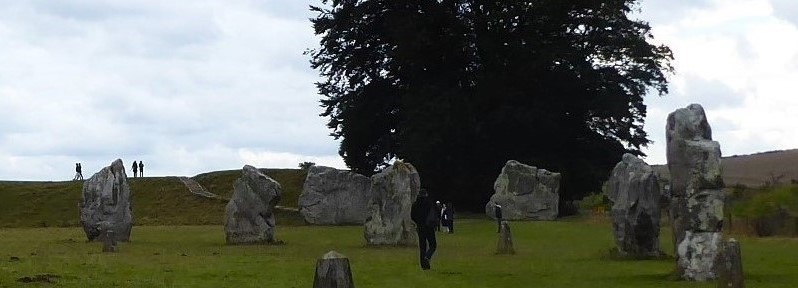Circles within circles.
I’m sorry for the delay in writing up this post, but my laptop gave up the ghost and died on me last week. Now back up and running with a new one. For an explanation on SARSEN STONES check back here –
SEARCHING SARSEN STONES.
***
This morning’s message on the way to the bus station. 
The no 49 drops me off at the Broad Hinton turnoff. It doesn’t visit the village so I don’t know what delights I may be missing. I do know I have to climb the hill back onto the downs. I even consider hitching a ride, but there are few cars, and I don’t suppose any would stop.
Ahead, I can see Hackpen White Horse just below the skyline. I leave the road at the bend and climb straight up the field to it. Once up close, it becomes white chalk where the soil has been scraped away. The horse was cut in 1837 by the Parish Clerk of Broad Hinton to commemorate the coronation of Queen Victoria. An off white horse was there to greet my arrival. There is a white horse back across the Vale on Snow Hill, Broad Town White Horse, but I couldn’t spot it. I mentioned the White Horse Trail yesterday.





Back up on The Ridgeway, I make good progress on the well surfaced and distinct path. I last came along here in 2010 when I was walking the Ridgeway LDW with my good old mate Mel. In parts It seems more enclosed than I remember. I meet a lady just setting off to walk the whole route, and a couple of cyclists doing the same. There are rough sarsen stones at the side of the track from time to time, whether these are just random or of somesignicance is hard to tell. All around are views to unknown downs. 




I’m looking for a short detour on the left. A gate opens onto a field full of cows, and I don’t like the sign. In the field is a sarsen stone that has been polished and grooved thousands of years ago by stone age men sharpening their stone tools? I summon the courage to venture across, the cows and maybe their bull seem far enough away. The large ‘polissoir’ stone is easily found. 


Back to The Ridgeway for a short distance before I veer off again to Fyfield Down Reserve. There are only sheep to contend with this time. The farmer is doing his rounds in a beaten up Discovery. He has a thousand sheep and 600 beef cattle. After a few hundred yards, I enter the top of a chalk valley whose surface is strewn with sarsen stones of all sizes. The largest collection in Britain. 



I even find a stone perfect for my lunch stop. My Tesco cheese and onion slice is a fraud, virtually hollow inside. Next time I’ll go to Gregg’s. 
My next diversion, and you couldn’t miss it out, was down a chalky path straight into the henge at Avebury. Being a Sunday, the crowds are out. Everyone is free to wander the site except for the ramparts of the henge. I have used figures to give some scale to my photos. There are a few stones on the outer ring and two smaller inner circles. Some of the stones are truly massive. Strangely, the road comes through the middle of the henge, and part of the village also is within it. One can only surmise that some of the missing stones will have been used as building material. Dating back to 2800-2500 BC, it is thought that the site might have been a grand meeting place, though the smaller circles suggest other ritual origins. We may never know. I have used an aerial shot from English Heritage to show the extent of the site. 












I leave the village in fields along the Avenue, a double row of stones, with many missing, leading directly south, possibly to the West Kennet Long Barrow. 

I consider visiting the barrow this afternoon, but more sensibly decide against it. Instead, I have more time to focus on the wide variety of lichens on the stones, a world of their own circles.



Climbing over the brow I come up close to Silbury Hill. What a view I get as I descend the other side. How and why come to mind? This rivals the pyramids, in my opinion, and maybe even older. It is on private land and, therefore, has been protected from erosion the masses would have inflicted. I am the only person admiring it, most don’t venture far out of the Avebury delights. 



A small, clear, chalk stream comes down the valley, its willows bending in the strong wind. 
 It is in fact bitter, and I’m relieved to reach the visitor centre and have a coffee. None of this tourist infrastructure was here the last time I visited. The National Trust own it all and makes a hefty profit on its coffee sales and no doubt parking fees.
It is in fact bitter, and I’m relieved to reach the visitor centre and have a coffee. None of this tourist infrastructure was here the last time I visited. The National Trust own it all and makes a hefty profit on its coffee sales and no doubt parking fees.


I wander past those two big stones again to catch the number 49 bus outside the Red Lion Inn. 


Back in Swindon, I navigate my way through the hoardings, which at least have some interest. “Sling shooting green energy into the future”. EdPoster. 
After a rest, I visit a Nepalese restaurant, Ghurkha, in town where the food I order is quite authentic. Vegetable Achar and steamed Momos. The owner is from Nepal, and we have a lovely conversation based on my several visits to that beautiful country. Nirvana, I could get used to this..















